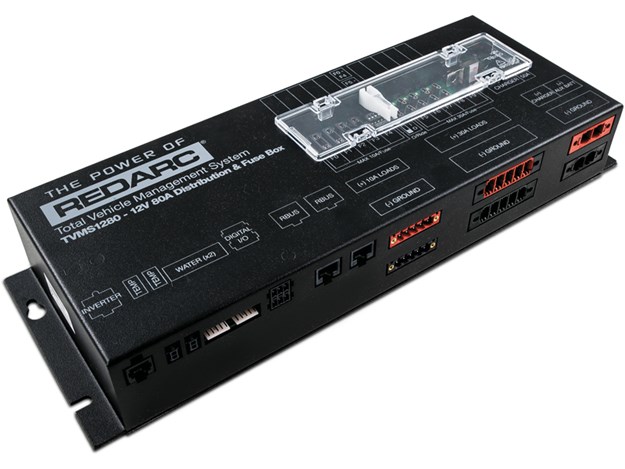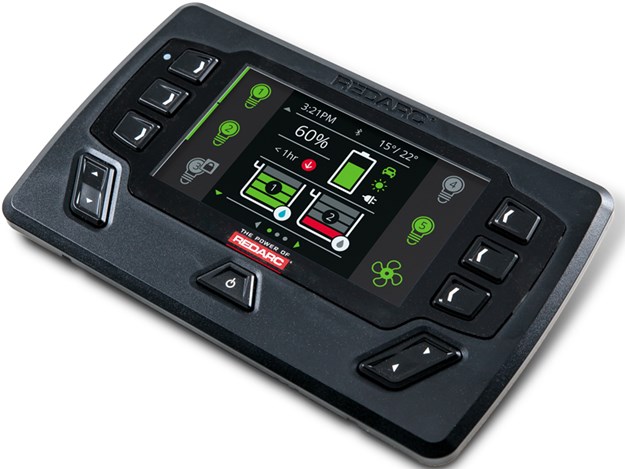Until just a few years ago RV house batteries could be charged directly from the primary vehicle’s alternator using a split charged system incorporating a Voltage Sensitive Relay (VSR).
 |
The Manager80; each fuse under the clear cover has a built-in LED that glows when it is blown |
Not a perfect system, it usually achieved around a 50-75 percent charge state, but it sufficed. That is until vehicle manufacturers in the EU had to meet increasingly stringent vehicle emission standards. Part of their solution for reducing emissions was to introduce an ECU controlled ‘smart’ or variable voltage alternator.
All-singing, all-dancing, the ‘smart’ alternator carries out many different tasks. It can be programmed to charge the vehicle battery to less than 100 percent, some as low as 60 percent, so there is battery capacity (headroom) to accept charge from regenerative braking (RB).
The problem here is that if the smart alternator only charges the start battery to 60 percent then the maximum state of charge the deep cycle house battery will achieve is 60 percent. The alternator also plays its part in the braking regenerative process by engaging when the vehicle is braking or coasting downhill, with the power created being stored in the ‘headroom’ in the vehicle battery.
In some situations, the ‘smart’ alternator output voltage is reduced, which saves fuel, but does not help the charging process for the house battery. Deep cycle house batteries aboard the RV look similar to starting batteries, but they are quite different inside.
The modern starting battery can cope with the high voltage generated by the smart alternator, but deep cycle house batteries require very specific voltages to achieve 100 percent state of charge and not be over or under-charged.
 |
The 4.3-inch high-res colour display |
‘Smart’ alternators’ output voltage can vary considerably. This does not suit deep cycle house batteries. At low voltage it won’t create a useful charge and at the high end it causes damage. VSRs don’t respond well either to extreme variable voltage.
They turn off when the voltage is too low, while allowing high (damaging) voltage to go through to the battery. This is why we need a DC to DC charger. This is their territory.
DC to DC chargers (aka battery to battery chargers) can handle high or low alternator output and modify it to the required voltage within the charge parameters of the battery(s) being charged, allowing 100 percent state of charge to be achieved.
They get there quicker (say x5) than a VSR system could, too. DC to DC chargers are connected between the starter battery and the house battery. Programmed for battery type (lead acid, gel, calcium, AGM or lithium), they deliver the correct voltage to the house battery.
DC to DC chargers can handle high or low alternator voltage and will adjust their current demand from the alternator accordingly. They’ve been available in New Zealand for a few years now, and brands currently on the local market are CTEK, Enerdrive, ePOWER and REDARC.
Some manufacturers, like REDARC, have combined the DC to DC charger with other RV essential electronic equipment, creating a Total Vehicle Management System (TVMS). The REDARC RedVision kit consists of four elements; a Battery Management System, a RedVision distribution box, a battery sensor and a 4.3-inch high-res colour display.
 |
All the components of the Battery Management System plus a 1500-watt pure sine wave inverter |
The Battery Management System, for example the Manager30, operates like six separate products; a DC to DC battery charger when the vehicle is on the move, a 240-volt 30 amp mains charger, a 30 amp MPPT solar regulator, a starting battery isolator, a load disconnect controller, and a remote battery monitor for up-to-date battery information and charge status.
The RedVision system centralises the information about the onboard devices and systems, and this data can be viewed on the 4.3-inch colour display unit. And REDARC has an app for most up-to-date Android and Apple devices so all the vital functions available on the 4.3-inch display can also be accessed on the app.
Be aware this is not a ‘one size fits all’ kit. Smaller and larger kits are available to suit camper trailers through to A class motorhomes. Or you can buy a DC to DC charger on its own. At first glance these kits appear expensive.
But if you’re starting from scratch the cost of each separate part plus the fitting cost will make the RedVision kits seem more affordable. The end result looks a lot tidier, too, and I suspect it will be a lot more reliable in the long run.





